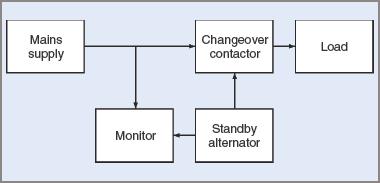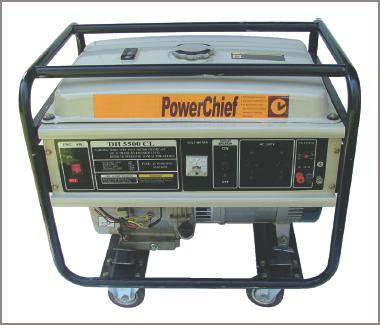Standby power supplies are generally intended to provide mains power at a specified voltage and frequency. There are two main types of standby power-supply units.
The first type of unit (uninterruptible) is meant for use where no interruption to a power supply can be tolerated, for example, to computer, hospital and aircraft navigation equipment. Losing power at a crucial moment in an operation could mean loss of life, or in the middle of a computer calculation could mean the loss of valuable data.
There is also an increasing use of this type of power supply for portable work because it can often be run from a 12 V vehicle battery. It is quick, convenient and quiet.
The second type of standby unit is where momentary losses of power can be tolerated. Such uses would include emergency lighting, theatres, and industrial uses such as fully environmental meat-chicken sheds.
Delays of several seconds in restoring power can be acceptable in some circumstances. This type of standby power supply would also be suitable for lifts and high-rise buildings.
A subsection of this latter category includes portable power supplies such as small generating plants that can be carried from job to job in a vehicle.
Uninterruptible Power Supplies (UPS)
A block diagram of a UPS is shown in Figure 1. It can be seen that the unit runs off the mains supply with a battery permanently ‘floating’ on charge from an inbuilt battery charger.
Effectively the battery bank is supplying an inverter, which converts DC to AC at mains voltage and frequency. In the event of losing mains power, the unit continues to operate as long as the battery has sufficient charge.

Figure 1 Block (Circuit) diagram of an uninterruptible power supply (UPS) with backup
More critical loads usually have an engine-driven alternator on standby to ensure that the battery charge is maintained. The battery capacity has to be great enough to supply the circuit power while the alternator and engine are being started and run up to speed.
Extra operating time allowances have to be made for non-starting incidents with the engine and also to provide greater flexibility as a backup in an emergency.
When using a vehicle battery, the DC values will be high, so care must be taken to ensure that the battery does not go flat. For example, a 500 W television set draws about 20 A on 32 V DC. The current drain would easily exceed 50 A on 12 V.
More modern inverter units are smaller and may draw less current, but they usually have a time rating of about 15 minutes or so and must then be switched off to cool down. A modern 500 VA unit probably has a continuous rating of about 150 VA.
Engine-Driven Alternators
A large range of engine-driven alternators is available, so a choice has to be made on the basis of several factors. These choices range from buying a small portable unit at the best possible price, to carefully planning for the most suitable unit for a particular purpose.
It is not simply a matter of selecting an alternator with respect to the load it has to supply; the choice should take into account many other considerations. Some of these factors are listed below and their order of importance is governed by the actual intended use for the alternator.
Figure 2 shows the essential components of standby power supply using an engine-driven alternator.

Figure 2 Block (Circuit) diagram for an engine-driven standby alternator
Purchase Price
The overall cost of smaller units may be lower, but in terms of cost per kVA they are more expensive and operate at lower efficiencies. As the size of the unit increases, the cost per kVA reduces, while the operating efficiency increases.
Type of Prime Mover
The economy of the prime mover in terms of efficiency has a bearing on its selection. This in turn is affected by the type of service it will encounter. For example, a steam turbine has good economy throughout its entire load range. However, it is expensive, large and needs a long time to get the unit on load from cold.
An internal combustion engine has poor efficiency at light loads but is much cheaper to buy initially. For some loads it is cheaper to buy several smaller alternators than one large unit. Problems of paralleling the units must then be considered.
The cost and availability of fuel must always be a consideration. While distillate is more expensive initially, as is the diesel engine itself, the fuel cost per hour is less, while maintenance costs are far higher than those for a petrol engine.
The petrol engine is cheaper to buy, the fuel is readily available, and the prime mover is suited to smaller units used purely for portable power supplies on intermittent duties. In the long term the diesel engine runs better on full loads than the petrol engine.
The petrol engine is more tolerant of dirty fuel than the diesel engine and does not need specialized skills for maintenance purposes. Figure 3 shows a portable generating unit driven by a single-cylinder petrol engine. Two 15 A outlets are available for connection of equipment.

Figure 3 Self-contained portable power supply. The alternator, rated at 5.5 kVA, is driven by a petrol engine. The size and weight of the unit is such that it can be moved to any site where power is required
Starting Methods
Starting methods are governed by the intended use of the generating unit. The quicker the changeover to auxiliary power, the more expensive is the starting method. The cheapest method involves merely starting the unit manually when it is evident that the main power supply has failed.
A more expensive method involves the use of an automatic changeover contactor that drops out when the main supply fails.
In turn this connects a starting motor to the engine and when the alternator is up to speed, connects it to the load.
Load Sizes and Alternator Capacities
Smaller generating plants are usually intended for standby purposes for short periods. They usually have only one load connected to them at a time, such as a portable tool or a small lighting load. With middle and larger sized alternators, consideration has to be given to the possible connection of intermittent larger loads, such as the starting currents of motors.
The unit then has to have the electrical capacity and engine power to maintain both the output voltage and the frequency during these current surges to avoid interruptions to other equipment connected to the same supply.
Operation of Alternators
With the exception of some manually operated equipment, most standby and back-up alternator operations are now beyond the control of the operator. Where some degree of manipulation is available there are two important factors that should always be considered; voltage and frequency.
In most cases the voltage is governed by automatic voltage regulators, while the frequency is controlled by the engine governor. The order of operation is to set the speed first, which in turn sets the frequency, and then adjust the voltage of the unit. To do this in the reverse order is to alter the voltage each time the speed is altered.
A study of the output voltage formula will confirm the soundness of this method.
![]()
In an operating alternator, the above formula can be reduced to the following:
![]()
Where k is a constant consisting of all the components of the formula that cannot be altered in an operating alternator. The flux value is altered by changing the DC excitation and the frequency is altered by changing the set point on the engine governor.